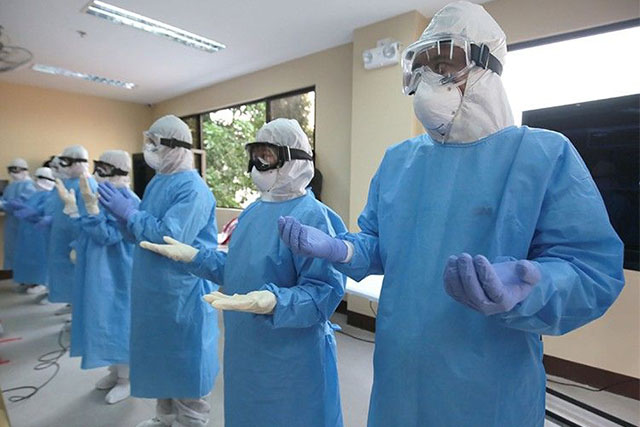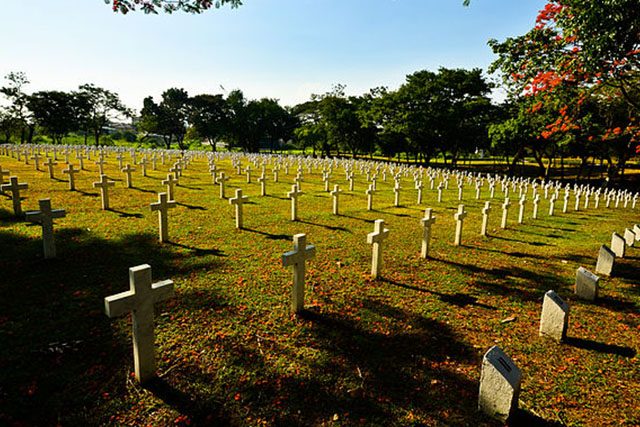Cabinet secretary and Inter-Agency Task Force Spokesperson Karlo Nograles expressed his support for a proposal to bury the medical frontliners who have lost their lives to the novel coronavirus disease at the Libingan ng mga Bayani (heroes’ cemetery).
He said that he personally backs Ako Bicol party-list Rep. Alfredo Garbin Jr.‘s call to honor the fallen frontliners by letting them be laid to rest at the distinguished gravesite.
However, Nograles said that the proposal still needs to be discussed by the IATF for the Management of Emerging Infectious Diseases.
“We have to review the laws kung kailangan ba ng amendment sa batas. Pero kung hindi naman kailangan, if it’s a policy decision lamang at kayang gawin ng IATF, then bakit hindi? O kung si Pangulo lang, bakit hindi?” he said in a press briefing last Sunday.
Presidential spokesperson Salvador Panelo said that the guidelines about the internment at the Taguig-based national cemetery “may be amended through a mere executive issuance to include the said frontliners.”
Garbin earlier stressed that Filipino COVID-19 frontliners must be honored accordingly. He said their remains should be cremated then be laid to rest at the heroes’ cemetery
“Every Filipino frontliner who dies in this COVID-19 war deserves to be laid to rest at the Libingan ng Mga Bayani because of their supreme sacrifice for love of country, loyalty to the people, and devotion to their profession,” he said.
The Private Hospitals Association of the Philippines (PHAP) said that 21 doctors have already lost their lives due to the viral disease.
‘Keep our healthcare workers alive’
This proposal, however, earned mixed reactions from Filipinos who aired their concerns and praises on social media.
Some Filipinos said that the government should make sure the medical frontliners are given enough protection in their duty to ensure that they do not contract the disease that has claimed Filipinos’ lives.
In a tweet, former Comelec commissioner Gregorio Larrazabal said that a “much better proposal” would be to ensure that “concrete steps are taken to keep our healthcare workers alive.”
“Give them the much needed support, including PPEs (personal protective equipment). Honor (heroes) by keeping them ALIVE & SAFE,” he wrote.
A physician similarly said that providing PPE suits for healthcare workers must be the priority instead of talking about their burials.
“Before talking about heroes’ burials, please get our health workers PPEs… Please. Please lang,” Aileen Dualan wrote.
Another Filipino said, “Huwag tayo magpadala sa diskurso kung pwede ilibing mga magigiting na health care worker frontliners sa Libingan ng mga Bayani.”
“Doon tayo sa usapang anong ayuda para mas may kaseguruhan na mabubuhay sila habang nakikipag-laban,” the online user said/ added.
PHAP said that most frontliners have died as a result of the patients’ failure to disclose their real travel histories to places with confirmed cases, as well as the lack of PPE suits in hospitals, particularly in private ones.
“Marami silang sinasabi na dumating na pero actually walang nakukuha ‘yung private hospitals, private consultants tayo, we buy our own kaso wala ring makuha,” PHAP president Rustico Jimenez said earlier.
PPE suits are fully-body clothing required to be worn by healthcare workers who are dealing with patients with infectious diseases such as COVID-19. It reduces their potential to be exposed to bacteria and viruses in the hospital.

The suit consists of gloves, eye protection (like face shield and goggles), clothing (like a gown and apron), a head covering and shoe covers.
Nograles last week said that member companies of the Confederation of Wearable Exporters of the Philippines would produce medical-grade PPE suits “after Holy Week.”
They are expected to produce as much as 10,000 suits per day.
Meanwhile, other Filipinos agreed with Garbin’s proposal and said that frontliners, being the “real heroes” of the pandemic, deserved to be buried at the Libingan ng mga Bayani.
“For some time we have lost our understanding of what is a hero. A hero is someone who will face adversities to save our lives. Frontliners ay dapat nasa Libingan ng mga Bayani,” a Twitter user said.
“We are currently at war with COVID-19. Frontliners are the soldiers. Fallen frontliners are casualties of this war. They definitely deserve a spot in the Libingan ng mga Bayani,” another online user wrote.
Who are allowed to be laid to rest at Libingan ng mga Bayani?
The Libingan ng mga Bayani is a gravesite reserved for the final resting place of former presidents, government dignitaries, statesmen, national artists and citizens considered heroes or martyrs.
It is a property owned by the Armed Forces of the Philippines which has guidelines on the internment at the national cemetery.
Under the AFP Regulation G 161-375 or “The Allocation of Cemetery Plots at the Libingan ng mga Bayani,” the following can be interred at the cemetery:
- Medal of Valor awardees
- Presidents or commanders-in-chief, AFP
- Secretaries of the National Defense
- AFP chiefs of staff
- Generals or flag officers of the AFP
- Active and retired military personnel of the AFP
- Former AFP members who laterally entered or joined the Philippine National Police and the Philippine Coast Guard
- Veterans of Philippine Revolution of 1896, WWI, WWII and recognized guerrillas
- Government Dignitaries, statesmen, national artists and other deceased persons whose interment or reinterment has been approved by the Commander-in-Chief, Congress or the Secretary of National Defense.
- Former presidents, secretaries of National Defense, widows of former presidents, secretaries of National Defense and chiefs of staff.










